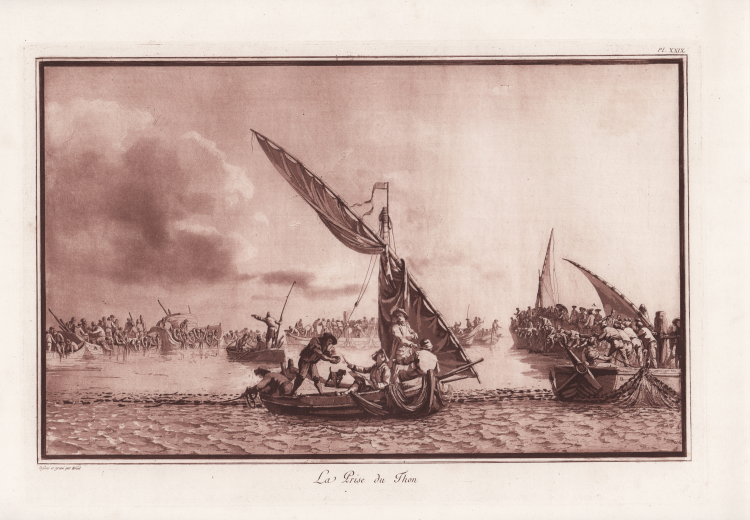



| Reference: | s31611 |
| Author | Jean Pierre Louis Laurent HOUEL |
| Year: | 1787 ca. |
| Zone: | Tuna fishing |
| Printed: | Paris |
| Measures: | 382 x 263 mm |


| Reference: | s31611 |
| Author | Jean Pierre Louis Laurent HOUEL |
| Year: | 1787 ca. |
| Zone: | Tuna fishing |
| Printed: | Paris |
| Measures: | 382 x 263 mm |
A beautifully rendered plate from Voyage Pittoresque des Isles de Sicile, de Malte et de Lipari.
Le Voyage Pittoresque by Hoüel is a travel diary characteristic of the 18th century in which the author reveals both his scientific and aesthetic vocation. His book has enormous documentary value due to the accuracy of the illustrations and the richness of the text, which includes didactic notes and autobiographical and travel anecdotes.
Hoüel’s journey was funded by the king of France, Louis XVI. Although he was only intending to be in Sicily for one year, he eventually stayed there for four years. His financial support was tendered on the condition that the money advanced by the king should be returned along with the proceeds of the published book.
However, the repayment was demanded too soon for Hoüel and the artist decided to repay part of the debt by donating some Sicilian paintings. Forty-six gouaches were chosen to enlarge the Painting Museum of Versailles (today preserved at the Louvre). Eventually, Hoüel and his creditor, the Compte Angiviller (administrator of the King’s properties) went their separate ways and the painter was left to manage the publication of his book himself. The Russian Empress Catherine II became interested in the acquisition of Hoüel’s ‘Cabinet’, comprising approximately five hundred gouaches, for which she paid forty thousand pounds. The works were sent to Saint Petersburg; 240 drawings disappeared and 264 works are now preserved at the HermitageMuseum.
The four folio volumes of the VOYAGE PITTORESQUE DES ISLES DE SICILE, DE MALTE ET DE LIPARI, où l’on traite des Antiquités qui s’y trouvent encore; des principaux Phénomènes que la Nature y offre; du Costume des Habitans, & de Quelques Usages was printed from 1782-1787. They contain 264 aquatint plates on 263 leaves (plates 245 and 246 printed on the same leaf), all printed in sepia.
Aquatint engraving printed in sepia on laid paper, very good condition.
Jean Pierre Louis Laurent HOUEL (1735 - 1816)
|
Jean Houel was an eminent painter, engraver, and author, who first studied in Rouen with Jean-Baptiste Descamps. He later moved to Paris, where he became a pupil of Casanova, Jacques-Philippe Le Bas, and Noël Le Mire and was admitted into the Royal Academy of Painting & Sculpture in 1774. After establishing a reputation for himself, Houel began to circulate in the aristocratic circles of Paris, and under the patronage of the King, he traveled to Sicily in the 1770s. He remained there for several years, during which he executed numerous sketches and paintings of the landscape, inhabitants, antiquities, and ancient sites of Sicily and the neighboring islands of Malta and Lepari. Upon returning to Paris in 1779, he exhibited several of his Italian views at the Salon and later published them as engravings in a four-volume work entitled Voyage pittoresque des isles de Sicile, de Malte et de Lipari between 1782 and 1787. His atmospheric renderings were highly esteemed (Catherine the Great purchase hundreds of his drawings) and constitute an invaluable record of many historical monuments and classical ruins that no longer exist today.
|
Jean Pierre Louis Laurent HOUEL (1735 - 1816)
|
Jean Houel was an eminent painter, engraver, and author, who first studied in Rouen with Jean-Baptiste Descamps. He later moved to Paris, where he became a pupil of Casanova, Jacques-Philippe Le Bas, and Noël Le Mire and was admitted into the Royal Academy of Painting & Sculpture in 1774. After establishing a reputation for himself, Houel began to circulate in the aristocratic circles of Paris, and under the patronage of the King, he traveled to Sicily in the 1770s. He remained there for several years, during which he executed numerous sketches and paintings of the landscape, inhabitants, antiquities, and ancient sites of Sicily and the neighboring islands of Malta and Lepari. Upon returning to Paris in 1779, he exhibited several of his Italian views at the Salon and later published them as engravings in a four-volume work entitled Voyage pittoresque des isles de Sicile, de Malte et de Lipari between 1782 and 1787. His atmospheric renderings were highly esteemed (Catherine the Great purchase hundreds of his drawings) and constitute an invaluable record of many historical monuments and classical ruins that no longer exist today.
|